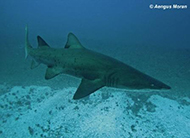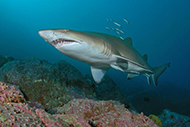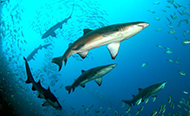
Priorities Action Statement - Actions for Greynurse Shark
Recovery Actions
Collate and review existing information
- Review and assess the potential threat of introduced species, pathogens and pollutants. Work undertaken under this action should be linked to action on Greynurse Shark post-mortem data recording and sampling (High priority).
- Review the level and spatial extent of protection measures at key aggregation sites to ensure appropriate levels of protection, and a consistent approach to the designation and implementation of protective measures, are applied (High priority).
- Identify and classify commercial fishing gear that has, or could potentially, interact with Greynurse Sharks to inform the development of management arrangements to mitigate interactions (Medium priority).
- Maintain review processes by state governments of the effect of shark control programs on the Greynurse Shark (Medium priority).
- Review and assess the effectiveness of voluntary and regulated diving arrangements, in relation to viewing Greynurse Sharks in their natural habitat, to ensure associated impacts continue to be minimised. Promote a consistent approach, where possible, among sites and across jurisdictions (Medium priority).
Community and stakeholder liaison, awareness and education
- Develop mechanisms and protocols that facilitate reporting by recreational fishers of interactions with Greynurse Sharks. Mechanisms chosen should foster the understanding that any reported interaction will be received without prejudice (Medium priority).
- Encourage recreational fishers (and spear fishers) to utilise the sighting program to report and provide, where possible, photographic evidence of sightings and interactions with Greynurse Sharks. Requested information from fishers should include estimated number, size and weight of sharks, as well as site location and depth (Medium priority).
- Develop and contribute to conservation oriented education programs in those commercial aquaria with captive Greynurse Sharks on display (Low priority).
- Access and evaluate effectiveness of prior or current education and awareness programs to identify alternative methods or improve efficacy (Low priority).
- Encourage community involvement in collaborative research, monitoring and education (Low priority).
Compliance / enforcement
- Maintain moratorium on the removal of Greynurse Sharks from the wild (High priority).
- Ensure appropriate controls are implemented in important habitat sites to reduce the risk of Greynurse Shark interaction with commercial fishing gear (Medium priority).
- Shark control programs to continue to report catches annually to the state governments (Medium priority).
- Strengthen awareness of, and encourage compliance with, the requirement to report grey nurse shark bycatch and mortality in commercial fisheries and recreational and charter fishing operations (Medium priority).
Enhance, modify or implement NRM planning processes to minimize adverse impacts on threatened species
- Ensure that fisheries management plans/strategies or other documentation reviewed for accreditation under the EPBC Act contain actions consistent with the recovery of the Greynurse Shark (where relevant), including reduction of bycatch and recording of all interactions (High priority).
- Ensure that any new, non-scuba diving related tourist operations aimed at viewing Greynurse Sharks have effective management arrangements to minimise impacts (Medium priority).
- Use Biologically Important Areas (BIAs) to help inform the development of appropriate conservation measures, including through the application of advice in the marine bioregional plans on the types of actions which are likely to have a significant impact on the species and updating such conservation measures as new information becomes available (Medium priority).
- Update and refine information on existing biologically important areas (BIAs) identified as part of the marine bioregional plans, and seek to identify new BIAs as information from research and other processes becomes available (Medium priority).
Research / monitoring
- Monitor and re-survey Greynurse Shark populations to assess population trends and dynamics, including estimates of population growth and mortality (High priority).
- Develop monitoring protocols and establish a national database to record data collected on Greynurse Shark, to assist with population monitoring (High priority).
- Evaluate the use of and develop new population models, using reliable data sets as they are collected, to reassess changes in extinction risks (High priority).
- Monitor the bycatch and mortality of Greynurse Sharks in relevant fisheries (all interactions are recorded) and report annually to the Department of Environment (DoE) (High priority).
- Undertake research into Greynurse Shark interactions with recreational fishing gear/methods to inform the development of risk mitigation strategies such as spatial, temporal or methods based restrictions (High priority).
- Continue research to locate habitat critical to the survival of the Greynurse Shark, including pupping, nursery and foraging areas (High priority).
- Monitor Greynurse Shark occupancy and utilisation of key aggregation sites (High priority).
- Collect, analyse and disseminate age, growth, reproduction, survival, mortality and diet information to further improve understanding of the population dynamics and habitat requirements of the Greynurse Shark (High priority).
- Continue to collect and analyse biological material for toxicology research and genetic analysis (for example to determine the stock structure, inbreeding depression, population boundaries and abundance), improve coordination of reporting and sampling programs and coordinate the collation of results and the storage of collected genetic, biological and toxicological material (High priority).
- Examine habitat use, ontogeny and regional connectivity across life history stages though the use of tagging technologies, including acoustic listening station networks, satellite tagging and photo identification (High priority).
- Conduct research to quantify post-release mortality rates of Greynurse Sharks caught incidentally in commercial fisheries (Medium priority).
- Quantify (through monitoring, reports and, where necessary, estimations of Greynurse Shark bycatch) mortality and non-lethal interactions in recreational fishing sectors and report annually to DoE (Medium priority).
- Continue to evaluate alternatives to shark meshing/drumlining, where bycatch levels are high, including the use of non-lethal methods or alternate strategies (Medium priority).
- Establish and implement uniform minimum standards for the continued biological, pathological, genetic, toxicological and other post-mortem data recording and sampling of Greynurse Sharks caught in shark control programs, using well established protocols. Develop a national database to collect this information (Medium priority).
- Develop a photo-tagging program for Greynurse Sharks caught and released in shark control programs, in conjunction with existing programs (Medium priority).
- Ensure consistent management protocols are developed and put in place for all existing captive Greynurse Shark programs to ensure individuals are appropriately managed. Determine whether it is feasible and appropriate for management protocols to enable captive breeding and investigate survivorship in captivity, to maintain a sustainable population without further collection from the wild (Low priority).
*(NB: the PAS actions for Greynurse Shark are taken from the approved Commonwealth recovery plan for this species. NSW DPI will be responsible for implementing only those actions of relevance to NSW).




